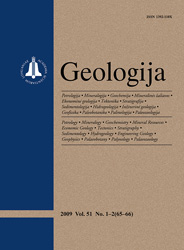Geologija / Geology
WHAT?
 ISSN 1392-110X ISSN 2029-056X (online) |
2007 m. Nr. 3 Estimation of geochemical profile of soil and sediments
in Lithuanian terrestrial and aquatic landscapes
The distribution of chemical elements in soils and river bottom sediments of Lithuania’s landscapes is analysed from the viewpoint of their formation period and absolute heights, assuming the prevalence of elements of natural genesis. On this basis, the distribution of four macro- (Ti, Zr, P and Mn) and eight microelements (Cr, V, Zn, Cu, Ni, Pb, Co, U) has been analysed. Their content was determined in samples taken from 4 (5) upland and 5 (6) lowland geomorphological regions formed 160–130 thousand years (Ašmena Upland as the relief of the penultimate Medininkai glaciation) to 25–13 thousand years ago (all other regions with the last glaciation relief forms). The prevailing upland altitudes range from 95–100 m (50–90 m in Linkuva Hill Range) to 260–290 m, while the lowland altitudes vary from 2–35 to 70–100 m above the sea level. There are eight soil groups of Level I observed in the above-mentioned geomorphological regions: Gleysols (GL), Albeluvisols (AB), Planosols (PL), Cambisols (CM), Leptosols (LP), Luvisols (LV), Arenosols (AR), and Histosols (HS). The grain size of these soils is characterised by eight deposit types: loam, sand, gravel, sand with sandy loam, sandy loam with loam, peaty loam, peat, and clay. The data show maximum contents of the elements studied in very fine dispersed river bottom sediments (with the exception of Lake Rėkyva containing minimum quantities). Contents of Ti, P, Mn, Cr, V (partly Zn) in the soils of upland areas increase going from the oldest and highest areas to the most recent and lowest upland regions. Contents of Cu, Ni, Pb, Co and U decrease in this direction. All these facts indicate intensive exogenous processes in relief development during a period over 120 thousand years, as well as a variety of chemical element migration (state) forms and migration extent for dissolved, colloidal or very fine-dispersed matter. Variations in element content are closely related to the soil groups and grain size. The distribution of the total content of elements shows their prevailing natural origin. The decrease in their content should be related to element-containing minerals and the intensity of their later migration, as well as to a possibly lower content of these elements in the initial moraines of the Last Glaciation versus that of the penultimate glaciation. There is an uneven distribution of elements in the soils of lowland regions formed at the end of the Late Pleistocene. The increase of their content in bottom sediments of rivers draining these lowlands is especially obvious in the rivers formed in the lowland regions 1.5–2 thousand years earlier. Such distribution is due to element migration from upland soils rich in these elements to the lowland rivers and accumulation in bottom sediments. Contents of elements in soils of different terrestrial landscapes are comparable to (or significantly lower than) those in the deposits of various origin and bottom sediments of the Kuršių Marios (Curonian) Lagoon and the Baltic Sea. Concentrations of elements in sediments of rivers draining these landscapes are slightly higher than in the Kuršių Marios, but lower than in the very fine-dispersed (pelitic) mud of the Baltic Sea. To assess the potential technogenous impact, when in the medium under study elements of natural origin prevail, comprehensive investigations on their migration (state) formsare necessary. Keywords: soil, bottom sediments, element distribution, geomorphological upland and lowland regions, terrestrial and aquatic landscapes |
Issues:
2011 - Vol.53 No. 1, No. 2, No. 3 2010 - Vol.52 No. 1-4 2009 - Vol.51 No. 1-2, No. 3-4 2008 - Vol.50 No. 1, No. 2, No. 3, No. 4, No. Priedas 2007 No. 1, No. 2, No. 3, No. 4 2006 No. 1, No. 2, No. 3, No. 4 2005 No. 1, No. 2, No. 3, No. 4 2004 No. 1, No. 2, No. 3, No. 4 2003 No. 1, No. 2, No. 3, No. 4 2002 No. 1, No. 2, No. 3, No. 4 2001 No. 1, No. 2, No. 3, No. 4 |